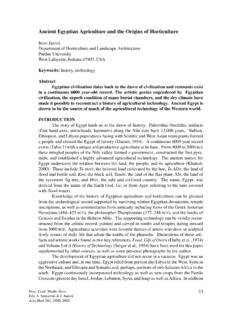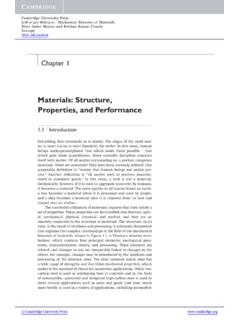Transcription of The Origins of Fruits and Fruit Growing - Purdue University
1 Janick, J. 2005. The origin of Fruits , Fruit Growing , and Fruit breeding. Plant Breeding Rev. 25:255-320. The Origins of Fruits , Fruit Growing , and Fruit Breeding Jules Janick Department of Horticulture and Landscape Architecture Purdue University 625 Agriculture Mall Drive West Lafayette, Indiana 47907-2010. I. INTRODUCTION. A. The Origins of Agriculture B. Origins of Fruit Culture in the Fertile Crescent II. THE HORTICULTURAL ARTS. A. Species Selection B. Vegetative Propagation C. Pollination and Fruit Set D. Irrigation E. Pruning and Training F. Processing and Storage III. ORIGIN, DOMESTICATION, AND EARLY CULTURE OF Fruit CROPS. A. Mediterranean Fruits 1. Date Palm 2. Olive 3. Grape 4. Fig 5. Sycomore Fig 6. Pomegranate B. Central Asian Fruits 1. Pome Fruits 2. Stone Fruits C. Chinese and Southeastern Asian Fruits 1. Peach 1. 2. Citrus 3. Banana and Plantain 4. Mango 5. Persimmon 6.
2 Kiwifruit D. American Fruits 1. Strawberry 2. Brambles 3. Vacciniums 4. Pineapple 5. Avocado 6. Papaya IV. GENETIC CHANGES AND CULTURAL FACTORS IN DOMESTICATION. A. Mutations as an Agent of Domestication B. Interspecific Hybridization and Polyploidization C. Hybridization and Selection D. Champions E. Lost Fruits F. Fruit Breeding G. Predicting Future Changes I. INTRODUCTION. Crop plants are our greatest heritage from prehistory (Harlan 1992; Diamond 2002). How, where, and when the domestication of crops plants occurred is slowly becoming revealed although not completely understood (Camp et al. 1957; Smartt and Simmonds 1995; Gepts 2003). In some cases, the genetic distance between wild and domestic plants is so great, maize and crucifers, for example, that their Origins are obscure. The Origins of the ancient grains (wheat, maize, rice, and sorghum) and pulses (sesame and lentil) domesticated in neolithic times have been the subject of intense interest and the puzzle is being solved with the new evidence based on molecular biology (Gepts 2003).
3 2. In the late neolithic and Bronze Ages between 6000 and 3000 BCE, the ancient Mediterranean Fruits (date, olive, grape, fig, sycomore fig, and pomegranate) were domesticated (Zohary and Spiegel-Roy 1975). Fruits such as citrus, banana, various pome Fruits (apple, pear, quince, medlar) and stone Fruits (almond, apricot, cherry, peach, and plum) were domesticated in Central and East Asia and reached the West in antiquity. A number of Fruits and nuts were domesticated only in the 19th and 20th centuries (blueberry, blackberry, pecan, and kiwifruit). Some well-known Fruits , although extensively collected, remain to be domesticated such as lingonberry, various cacti such as pitaya, Brazilnut, and durian. This review will consider the various technologies inherent in the Origins of some well known Fruits emphasizing factors that led to domestication and the genetic changes that ensued.
4 A. The Origins of Agriculture The change from food collection to food production requires the domestication of plants and animals. This involves a series of technologies that involves choice of species, bringing them into management or cultivation, genetic alteration brought about by selection both conscious and unconscious, and the discovery of specific practices (pollination, training, processing) often unique for each crop. Although precise Origins are obscure, the first archeological evidence for a developed agriculture is found in Mesopotamia and shortly after in the Nile and Indus Valleys. Evidence suggests a later development in China, Central America, East and West Africa and, perhaps, New Guinea (Diamond 1997, 2002). There is some dispute as to whether the Origins of agriculture were completely independent. Those who favor independent invention of agriculture emphasize the adaptability of humans for independent discovery and provide as evidence the domestication of different grains in various parts of the world wheat in the Mid-East, sorghum in Africa, rice in Asia, and maize in the Americas (Harlan 1992).
5 However, an argument can be made for diffusion based upon the sequential development of agriculture (Carter 1977). Although the diffusion of agricultural information has been ignored in favor of independent development, recent evidence on the domestication of the dog suggests that diffusion of agricultural information may indeed be involved (Leonard et al. 2002; Savolainen et al. 2002). The ancient neolithic trade in flint suggests diffusion was important to the transfer of ancient technology. It seems doubtful that the complex technology involved in such techniques as fire making, production of weapons like the bow and arrow, ceramic making, and metal working are 3. truly independent discoveries. Evidence of diffusion in the history of agricultural technology includes irrigation technology from Mesopotamia, silkworm technology from China, and horse technology from Central Asia.
6 In the Mid-East, the change from scavenging, collecting, and hunting to agriculture that occurred about 10 to 12 thousand years ago is rather sudden. Taking into consideration the long history of mankind, the term neolithic revolution has been coined for this rapid . transformation. The domestication of crops was preceded by animal domestication with Nomadism the link between animal agriculture and farming. The first crops domesticated in the Middle East include cereals, such as barley, emmer, and spelt, and pulse crops such as sesame and lentil. Cereal and pulse culture require a number of technologies, including land preparation, planting, harvesting, threshing, and seed storage, that form the basis of crop agriculture. Because the seed is produced following genetic recombination, thousands of generations occur in which selection, conscious and unconscious can bring about large changes.
7 The enormous morphological changes that can occur with selection associated with domestication is wonderfully apparent with the myriad breeds of dog, all shown to be domesticated from the wolf, and the changes in Brassica oleracea (broccoli, Brussels sprouts, cabbage, cauliflower), and Beta vulgaris (table beet, sugar beet, and chard). B. Origins of Fruit Culture in the Fertile Crescent Childe (1958) proposed that a second neolithic revolution coinciding with the Bronze Age occurred between 6000 and 3000 BCE involving the change from villages to urban communities. The evolution of urban centers is associated with the development of a settled agriculture. This coincides with the beginning of Fruit culture, which involved a long-term commitment to a unique piece of ground. In the case of the date and olive, a Fruit orchard can remain productive for over a century. It is Fruit culture that bonds humans to a particular piece of land and may be a link associated with the concept of territoriality, the development of city-states, and eventually nationhood.
8 Information on the ancient Origins of Fruit culture comes from archeological remains of Fruit , and from pictorial and literary evidence. The high culture of Mesopotamia and Egypt produced a rich art in which Fruit is a common motif. A trove of paintings and sculpture is found in Egyptian tombs and monuments. The Sumerian discovery of writing in the 3rd millennium BCE, and 4. Egyptian writings somewhat later, inaugurated the literary tradition that survives today as a result of the near indestructibility of the baked clay tablets used for cuneiform script, the wide use of stone carving for hieroglyphics, and the preservation of papyrus in desert tombs. Zohary and Spiegel-Roy (1975) proposed that Fruit culture, in contrast with mere collection, originated 4000 to 3000 BCE. Although some information before this period is based on archeological remains, much of it is by inference and conjecture.
9 Perhaps the earliest pictorial evidence of Fruit Growing occurs in a 1 m tall alabaster vessel known as the Uruk vase found in Jemdet Nasr levels at Uruk that date from about 3000 BCE (Fig. 1). Uruk (Erech) is on the Euphrates just north of Basra, Iraq. The imagery depicts water at the bottom of the vase, followed by plants (barley and sesame) and domestic animals, and men bearing baskets of Fruit with offerings presented to a female, perhaps the Goddess Innana, later known as Istar (Bahrani 2002). Unfortunately the Fruits cannot be identified, but they tend to be large and of various shapes. Predynastic drawings of Fruit trees in Egypt depict the date palm (Fig. 2). The development of Fruit culture in the Fertile Crescent evolved at two loci: the Tigris- Euphrates civilization of Mesopotamia and the Nile valley culture of Egypt. Later infusions of species and technology are from Greece, Persia, Turkey, India and China.
10 By classical times in Greece and Rome Fruit culture had achieved a sophisticated level, not exceeded for over a millennium. II. THE HORTICULTURAL ARTS. Fruit Growing involves a more complicated technology than the cultivation of herbaceous annuals such as cereals or pulse crops. Tree crop culture requires a long-term series of horticultural craft secrets more or less unique for each species. These include selection of unique clones, vegetative propagation (use of offshoots, cuttings, grafting), continuous irrigation in dry climates, pruning and training, pollination, harvesting, storage, and processing. The cycle of Fruit Growing is often a year-round activity, and must involve orchard establishment in anticipation of production, which may only ensue after a number of years. Current additions to the technology of Fruit Growing include the use of dwarfing rootstocks, growth regulators, disease and pest control, long-term storage, protected cultivation, and biotechnology.



